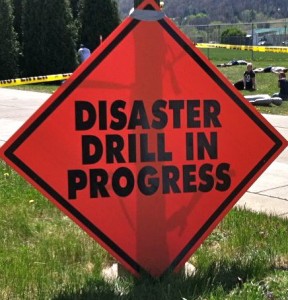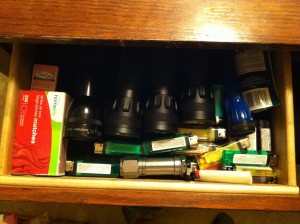 When the lights go out (power failure) it tends to be during the worst times. Hopefully each of us has a plan, for our household, about what to do for light, heat (or cool), backup power, and entertainment. But does your family know your plan? Unfortunately many of us have a loose plan in mind and assume we’ll figure it out when it happens. But what if you’re not home or unavailable to help?
When the lights go out (power failure) it tends to be during the worst times. Hopefully each of us has a plan, for our household, about what to do for light, heat (or cool), backup power, and entertainment. But does your family know your plan? Unfortunately many of us have a loose plan in mind and assume we’ll figure it out when it happens. But what if you’re not home or unavailable to help?
This week, during a calm time, we had a “lights out” drill. Sure the power was out, for real, in January, but Ryan was the only one of the kids at our house during that time (the girls were with their mom, and chose to stay there). The girls insisted that they’d be fine and had been through it all before, but I asked them to humor me.
 We waited until it got dark, so things would be a more realistic. I started by showing them where the circuit box was, and briefly explained it’s function and how to reset the circuits. We then turned off all the power (except to the refrigerator). I had them go get flashlights, carefully because it was now dark; they thought that was easy because they all know the flashlights are kept in the table drawer.
We waited until it got dark, so things would be a more realistic. I started by showing them where the circuit box was, and briefly explained it’s function and how to reset the circuits. We then turned off all the power (except to the refrigerator). I had them go get flashlights, carefully because it was now dark; they thought that was easy because they all know the flashlights are kept in the table drawer.
When they returned to the garage, I tried to show them how to open the garage door manually if the power was out. (Let me preface this by saying we recently got a new garage door opener.) I pulled the red cord to disconnect the garage door opener and it wouldn’t come loose. Sarah and I spent a few minutes trying to figure it out and were unable to get it to release or open the door. At that point we left it for later–and I still need to figure out why it didn’t work–but that was much better time to find out it didn’t work, then to find out when we NEEDED to get a car out of the garage and the power was out.
 I then gave them a brief overview of our inverter and battery bank (with some hands-on) and showed them how to: check the battery levels, connect to to the inverter, turn it on, and reset it if necessary. I showed them which extension cords to use, how to plug-in the furnace, and then pulled the extension cord into the house. We discussed what we could power with the battery bank: lamps, TV/DVD, phone chargers, limited microwave, and what couldn’t be powered: refrigerator, oven, dishwasher, Tivo, coffee maker. We plugged in the standing lamps (with the LED bulbs), so we had light again. For practice, we got out the kerosene lanterns and lit them (and got out the fire extinguisher and set it nearby, just in case). Sarah then plugged in the TV and DVD player and we watched the movie Up, while the “power was out”.
I then gave them a brief overview of our inverter and battery bank (with some hands-on) and showed them how to: check the battery levels, connect to to the inverter, turn it on, and reset it if necessary. I showed them which extension cords to use, how to plug-in the furnace, and then pulled the extension cord into the house. We discussed what we could power with the battery bank: lamps, TV/DVD, phone chargers, limited microwave, and what couldn’t be powered: refrigerator, oven, dishwasher, Tivo, coffee maker. We plugged in the standing lamps (with the LED bulbs), so we had light again. For practice, we got out the kerosene lanterns and lit them (and got out the fire extinguisher and set it nearby, just in case). Sarah then plugged in the TV and DVD player and we watched the movie Up, while the “power was out”.
 After the movie I turned the power back on; I figured they already knew how to sleep in the dark. I finished up the following morning having Ryan make coffee without power, he used the hand grinder and the french press. I had meant to pull out the generator that morning and show the girls how to use it, but I forgot. Next time.
After the movie I turned the power back on; I figured they already knew how to sleep in the dark. I finished up the following morning having Ryan make coffee without power, he used the hand grinder and the french press. I had meant to pull out the generator that morning and show the girls how to use it, but I forgot. Next time.
(Funny story though: A few weeks ago I got out the generator, in the middle of the afternoon, and started it up for our quarterly testing. One of the neighbors was working in his yard and asked if our power was out. I told him we were just practicing and checking the equipment, he replied, “That’s probably a good idea, easier now then when you really need it.” I couldn’t have agreed more.)
Our lights out drill went well. I tried to keep it simple and relatively painless. The kids were pretty good sports and are now more familiar with our procedure.
Teach your kids–and spouse–the skills you know; you may not be around when they are necessary. And remember, “To teach is to learn twice.” (- Joseph Joubert)
(Friday: What We Did This Week To Prep)























